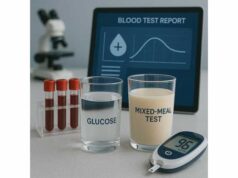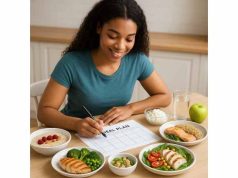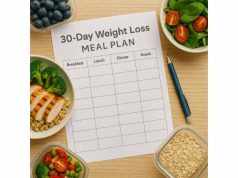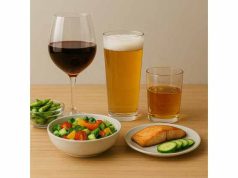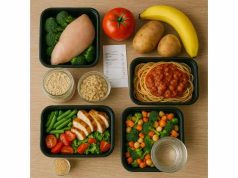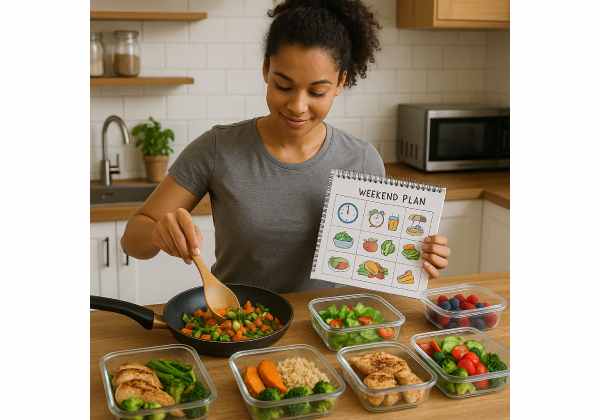
You do not need a full Sunday in the kitchen to eat well all week. With a clear checklist and a timer, one focused hour can stock ready-to-eat proteins, vegetables, grains, and sauces that assemble into fast, satisfying meals. The goal is not gourmet—it is repeatable. Build a short shopping list, cook with sheet pans and one pot, and portion with simple visuals so your weekday choices are automatic. If you still need to set calorie targets and macro ranges, start with our guide to calorie and macro planning, then use the plan below to make those numbers effortless.
Table of Contents
- Meal prep for weight loss
- One-hour weekend plan
- Menu blueprint and recipes
- Grocery list and budget
- Storage safety and reheating
- Mistakes and troubleshooting
- Track progress and adjust
- Frequently Asked Questions
Meal prep for weight loss
Meal prep is not a diet. It is a system that removes friction so you can follow the plan you already chose. Prepped foods reduce the “what is for dinner?” tax, keep portions consistent, and make it harder to drift into takeout. When you decide once and repeat all week, your calorie deficit becomes quieter and easier to maintain.
Why it works
- Decision simplicity: You build a few “default meals,” then rotate them. Less choice means fewer detours.
- Protein anchors: Ready-to-eat proteins (chicken, tofu, fish, eggs, yogurt) keep meals in the 25–40 gram range so hunger is steadier and evening snacking drops.
- High-volume sides: Batch-cooked vegetables and soups add bulk to plates without many calories.
- Measured rich ingredients: Olive oil, nuts, sauces, and dressings are portioned once, not guessed nightly.
How this plan is different
- One hour, hard stop. You will batch-cook two proteins, one pot of grains or starchy veg, two trays of vegetables, and two sauces or dressings. That is it.
- Exact timeline. We stack tasks so something is always cooking while you chop.
- Mix-and-match design. Every prep item pairs with the others, so you can build breakfasts, lunches, dinners, and snacks from the same parts with minimal thinking.
Portion control made automatic
Use the plate method at assembly: half vegetables, a palm of protein, a cupped hand of carbs, and a thumb of fats. If you need a visual refresher on sizing, skim our practical guide to portion sizes and plate balance and then come back here.
What this plan assumes
- You want simple, high-protein, high-fiber meals that reheat well.
- You are comfortable with sheet pans, a pot, a skillet, and basic seasoning.
- You can spend 10–12 minutes per meal on weeknights to assemble and finish.
Results you can expect
- Faster weekday decisions, fewer high-calorie improvisations, and steadier weight trends.
- A grocery list that fits in one basket and repeats easily.
- Less “all or nothing”—a missed night does not break the week because the parts are waiting in the fridge.
If you have not reviewed safe pacing for weight loss or how to set expectations, spend five minutes with our quick overview of safe weight-loss basics. Then set a timer and prepare to cook with a plan.
One-hour weekend plan
Set a 60-minute timer. Follow the timeline below exactly the first two weekends. After that, customize freely. The yields serve two people for five workdays or one person for a full week with some leftovers.
Equipment
- Two rimmed sheet pans, one large pot, one skillet, cutting board, sharp knife, measuring spoons, two mixing bowls, storage containers.
Menu parts you will batch
- Proteins (choose two): chicken breast or thighs; tofu or tempeh; turkey meatballs; salmon or white fish; hard-boiled eggs; lentils (if you eat legumes).
- Starches (choose one): brown rice, quinoa, farro, potatoes, or sweet potatoes.
- Vegetables (choose two trays): broccoli and carrots; peppers and onions; Brussels sprouts and squash; green beans and mushrooms.
- Sauces (choose two): lemon-herb vinaigrette; tahini-garlic; salsa verde; yogurt-dill; tomato-pepper sauce.
Minute-by-minute timeline
- 00:00–05:00 — Preheat and rinse.
- Oven to 220°C / 425°F.
- Rinse 2 cups quinoa or rice or scrub 1.2 kg potatoes/sweet potatoes (cube for speed).
- Boil water for grains or set up a steamer if you prefer.
- 05:00–10:00 — Start grains and eggs.
- Put grains in the pot with salted water (cook per package).
- Optionally add 6–12 eggs to a saucepan for hard-boiling (cover with water; bring to boil; turn off heat; cover 10–12 minutes; ice bath).
- 10:00–15:00 — Chop vegetables.
- Tray 1: 600 g broccoli florets + 3 large carrots (coins).
- Tray 2: 3 bell peppers + 1 large red onion (strips).
- Toss each tray with 2 tsp olive oil, salt, pepper. (Measure oil; do not “glug.”)
- 15:00–20:00 — Season proteins.
- Chicken: 1 kg breasts/thighs with 1 tbsp olive oil total, paprika, garlic, salt, pepper.
- Tofu: 450–600 g extra-firm, pressed; toss with soy or coconut aminos, smoked paprika, pepper; 2 tsp oil.
- 20:00–35:00 — Roast everything.
- Slide both veg trays in; set 20–25 minutes.
- Add a third pan with chicken (or bake tofu on one side of a veg tray).
- Flip vegetables at the halfway mark for even browning.
- 35:00–45:00 — Make two sauces.
- Lemon-herb vinaigrette: 3 tbsp olive oil, juice of 1 lemon, 1 tsp Dijon, salt, pepper, oregano.
- Tahini-garlic: 3 tbsp tahini, juice of ½ lemon, 1 grated garlic clove, water to thin, pinch of salt.
- Whisk and taste; thin with water or vinegar as needed.
- 45:00–55:00 — Portion and cool.
- Drain grains; fluff.
- Pull trays; rest proteins 5 minutes.
- Peel eggs (if making).
- Lay lids ajar to cool quickly.
- 55:00–60:00 — Label and store.
- Label containers with food and date.
- Refrigerate within 60 minutes of cooking.
Yield targets (adjust to household)
- Protein: 8–10 palm-size portions total (about 120–150 g cooked each).
- Grains or potatoes: 8–10 cupped-hand portions (about 125–150 g cooked each).
- Vegetables: 10–12 fist-size portions.
- Sauces: 10–12 tablespoons of dressing across the week.
Assembly rhythm (weekday)
- Lunch bowls: 1 palm protein + 1 cupped hand grains/potatoes + 2 fists vegetables + 1 tbsp sauce.
- Dinners: same template; add a quick side salad or fruit.
- Breakfasts: eggs or yogurt with fruit; reuse roasted potatoes or grains where you like a savory bowl.
If you want to connect this workflow to a macro split, skim our quick overview of macro ratios and then keep using the same assembly rules—they align naturally.
Menu blueprint and recipes
Here is a simple blueprint you can repeat weekly. Each option keeps protein high, vegetables generous, and calories controlled through measured fats and smart carbs.
Breakfasts (choose 2 to repeat)
- Greek yogurt bowl
- 1 cup plain Greek yogurt or skyr
- ½–1 cup mixed berries
- ⅓ cup muesli or oats (optional)
- 1 tsp chopped nuts, cinnamon
- Egg and vegetable skillet
- 2–3 eggs scrambled with 2 cups vegetables (use roasted leftovers)
- 1 tsp olive oil in the pan
- Optional: small roasted potato wedge portion
- Savory tofu scramble
- 150–200 g tofu, crumbled
- 2 cups spinach, mushrooms, onion
- Turmeric, garlic, black pepper
- Finish with lemon and herbs
Lunch bowls (mix-and-match)
- Mediterranean: chicken + quinoa + roasted peppers/onions + cucumber + olives + lemon vinaigrette.
- Southwest: tofu + roasted broccoli/carrots + roasted potatoes + salsa verde + lime.
- Market veg: salmon (or eggs) + farro + roasted greens + tahini-garlic + herbs.
Dinners (10-minute finishes)
- Sheet-pan reheat: Spread vegetables and potatoes on a tray, top with sliced chicken or tofu, warm at 200°C / 400°F for 8–10 minutes; finish with a spoon of sauce.
- Speed stir-fry: Sauté a handful of vegetables, add pre-cooked protein, and toss with 1–2 tbsp tomato-pepper sauce; serve over grains.
- Brothy bowl: Simmer a quick broth, add a palm of protein, a fist of vegetables, and a scoop of grains; top with lemon and herbs.
Two fast recipes to keep
Turkey meatballs (bake once, freeze some)
- 900 g lean turkey, 1 egg, 2 tbsp minced onion, 1 tsp each salt, pepper, garlic, paprika.
- Form 20 small balls; bake at 220°C / 425°F for 12–14 minutes until cooked through.
Tomato-pepper sauce (multi-use)
- Sauté 1 onion and 2 peppers (sliced) in 1 tsp olive oil.
- Add 2 cups crushed tomatoes, 1 tsp smoked paprika, salt, pepper; simmer 10 minutes.
- Use for shakshuka, meatballs, or a quick pasta swap over farro.
Snacks (100–250 calories, protein-forward)
- 170 g Greek yogurt with fruit
- 2 hard-boiled eggs and cherry tomatoes
- Cottage cheese with cucumber (if you include dairy)
- Edamame (¾ cup shelled)
- Apple with 1 tbsp peanut butter (measure)
Protein substitutions
Rotate salmon, shrimp, lean beef strips, tempeh, or canned fish to avoid boredom. For a printable list of protein options with serving sizes, use our concise high-protein food list and pick five you actually enjoy.
Grocery list and budget
A short, repeatable list keeps costs down and speeds shopping. Choose one item from each line for variety.
Produce (8–10 items)
- Vegetables: broccoli, carrots, peppers, onions, zucchini, green beans, Brussels sprouts, leafy greens, mushrooms
- Starches: potatoes or sweet potatoes
- Fruit: berries, apples, oranges, bananas, grapes, melon
- Flavor: lemons or limes, garlic, fresh herbs (parsley, cilantro)
Proteins (2–3 items)
- Chicken breast/thighs, ground turkey, extra-firm tofu or tempeh, salmon or white fish, eggs, canned tuna or sardines
Grains (1–2 items)
- Brown rice, quinoa, farro, barley, or whole-grain couscous
Pantry
- Olive oil, vinegars (red wine, balsamic), tahini, Dijon mustard, tomato paste or crushed tomatoes, spices (paprika, cumin, oregano), low-sodium broth
Containers and tools
- 6–10 meal containers, 2–3 small jars for sauces, labels or masking tape
Budget tips
- Buy proteins on sale and freeze extras in palm-size portions.
- Choose frozen vegetables for cost and speed; mix with fresh for texture.
- Use whole grains and potatoes as your main carb—they are inexpensive and filling.
- Flavor with herbs, citrus, garlic, and vinegar; keep oil measured to teaspoons.
- Cook a double batch of grains to cover breakfasts and dinners.
If you are trimming grocery costs further, adapt ideas from our practical budget meal plan strategies and swap in the affordable proteins you prefer (canned fish, eggs, tofu).
Storage safety and reheating
Great prep is useless if it spoils or dries out. Use these rules to keep food safe, tasty, and ready when you are.
Cooling and storing
- Refrigerate cooked foods within 60 minutes.
- Divide into shallow containers so they cool quickly and evenly.
- Keep sauces separate; add at serving so vegetables stay crisp.
- Label each container with the date and content.
Fridge and freezer timelines (typical home fridge)
- Cooked chicken, turkey, tofu, grains, and roasted vegetables: 3–4 days refrigerated.
- Hard-boiled eggs (shell on): up to 1 week.
- Soups and tomato-based sauces: 4–5 days; freeze portions for up to 3 months.
- Cooked fish: 2–3 days (plan earlier in the week).
- Frozen meals: best quality within 2–3 months; thaw overnight in the fridge.
Reheating for quality
- Sheet-pan method (best texture): 200°C / 400°F for 8–10 minutes to revive roasted veg and proteins.
- Skillet method (fast): Add a splash of water or broth, cover 2–4 minutes, then uncover to evaporate.
- Microwave (convenient): Cover loosely, power 70–80%, stir halfway; add 1 tsp water to prevent drying.
Pack like a pro
- Keep delicate greens and fresh herbs un-dressed; add just before eating.
- Store cut fruit separately to avoid soggy salads.
- Use small jars for nuts and seeds; sprinkle at the table for crunch.
If you pack lunch for commutes or long shifts, scan our time-saving ideas in make-ahead lunches and plug them into this same prep structure.
Mistakes and troubleshooting
Even tight systems drift. Here are the issues that most often stall progress—and quick fixes that work.
“Healthy” oils without measuring
Olive oil is excellent for flavor and satiety, but a generous pour can add 120–200 calories.
Fix: Measure oils by teaspoon during cooking and use vinaigrettes by tablespoon. Thin with lemon or vinegar to stretch flavor.
Protein too low at breakfast
Low-protein mornings lead to bigger dinners and late-night snacking.
Fix: Aim for 25–40 g at breakfast: eggs with vegetables, yogurt with fruit, or tofu scramble. Keep snacks protein-forward.
Bland food and drift to takeout
Under-seasoned meals push you toward restaurant options.
Fix: Rely on acids and herbs: lemon, vinegar, garlic, fresh herbs, and chili flake. Make two sauces each weekend for variety.
Over-prepping complicated recipes
Complex dishes make prep feel like a chore.
Fix: Batch parts, not elaborate meals. Assemble flavor at serving with sauces and fresh herbs.
Pasta and bread creep
Easy to overserve and crowd out vegetables.
Fix: Keep carbs to one cupped hand per meal; load plates with vegetables first. If you need comfort, swap in potatoes or grains you can portion by scoop.
No plan for restaurants
One dinner out can erase a week’s deficit if portions balloon.
Fix: Use the plate method when eating out; prioritize grilled proteins, double vegetables, and a measured starch. If you need a broader checklist, skim our guide to common diet mistakes and pick one lever to adjust this week.
Track progress and adjust
Meal prep builds consistency. Progress comes from small course corrections you make every two weeks based on the trend, not a single day.
Track the right signals
- Weight trend: Weigh 2–4 mornings per week, same routine, and average the numbers. Look at 14-day changes.
- Adherence markers: How many meals did you assemble from your prepped parts? Which nights did you default to takeout and why?
- Satiety feedback: Where did hunger spike—late afternoon, late evening, or after workouts?
Make targeted adjustments
- If hunger is high: Raise per-meal protein by 5–10 g and add a fist of vegetables or ½ cup beans (if included in your pattern).
- If weight stalls for two weeks: Reduce added fats by 1 tsp at two meals per day or trim carbs by ½ cupped hand at dinner. Keep protein and vegetables steady.
- If training increased: Keep protein constant and add 15–30 g carbs pre- and post-workout from fruit or potatoes.
Keep the system fresh
- Rotate one new spice or sauce each week.
- Swap one protein (e.g., chicken → salmon or tofu).
- Use theme weeks (Mediterranean, Tex-Mex, market veg) without changing the workflow.
Consistency, not novelty, drives results. The one-hour weekend habit is your floor—something you can do on your worst week and still stay on track.
Frequently Asked Questions
How many meals can one hour of prep cover?
A typical hour yields 8–10 protein portions, 8–10 scoops of grains or potatoes, and 10–12 vegetable servings—enough for five workdays of lunches and several dinners for one to two adults. If you need more, add a third tray of vegetables or a second grain pot.
Do I have to count calories if I meal prep?
Not necessarily. Use the plate method: half vegetables, a palm of protein, a cupped hand of carbs, and a thumb of fats. If your 14-day weight trend stalls, briefly measure oils and starches to recalibrate, then return to visuals. Protein should stay consistent.
What proteins reheat best without drying out?
Chicken thighs, turkey meatballs, tofu or tempeh, and salmon with a sauce hold moisture well. Reheat with a splash of water or broth and cover for the first minute. Avoid overcooking in the initial prep to keep texture tender through the week.
How do I meal prep if I am vegetarian?
Batch tofu or tempeh, roast two trays of vegetables, cook a pot of grains, and make a protein-friendly sauce (tahini or yogurt if you include dairy). Aim for 25–40 g protein at meals using tofu, tempeh, eggs, skyr, or a bean-and-grain combination.
Can I freeze prepped meals?
Yes. Freeze soups, meatballs, cooked grains, and extra proteins in single portions for up to 2–3 months. Thaw overnight in the fridge. Roasted vegetables freeze less well; use them within 3–4 days or repurpose into soups and sauces before freezing.
How do I prevent boredom with the same foods?
Change sauces and herbs weekly, swap one protein, and vary your vegetables by color and texture. Keep a short list of “defaults” and rotate themes (Mediterranean, Southwest, market veg) so effort stays low while flavors change.
References
- Are Dietary Proteins the Key to Successful Body Weight Management? A Systematic Review and Meta-Analysis of Studies Assessing Body Weight Outcomes after Interventions with Increased Dietary Protein 2021 (Systematic Review & Meta-Analysis)
- Effect of Protein-Rich Breakfast on Subsequent Energy Intake and Subjective Appetite in Children and Adolescents: Systematic Review and Meta–Analysis of Randomized Controlled Trials 2021 (Systematic Review & Meta-Analysis)
- Diabetes Meal Planning | Diabetes | CDC 2024 (Guidance)
- Cold Food Storage Chart | FoodSafety.gov 2023 (Guideline)
- 4 Steps to Food Safety | FoodSafety.gov 2023 (Guideline)
Disclaimer
This article offers general nutrition and meal-planning guidance for adults. It is not a substitute for personalized medical advice, diagnosis, or treatment. If you have a medical condition, take prescription medications, are pregnant, or are breastfeeding, consult your healthcare professional before changing your diet.
Share and follow
If this one-hour system helped you simplify weekday eating, consider sharing it with a friend who wants stress-free, healthy meals. For steady, research-based tips, follow us on the social network you use most.

